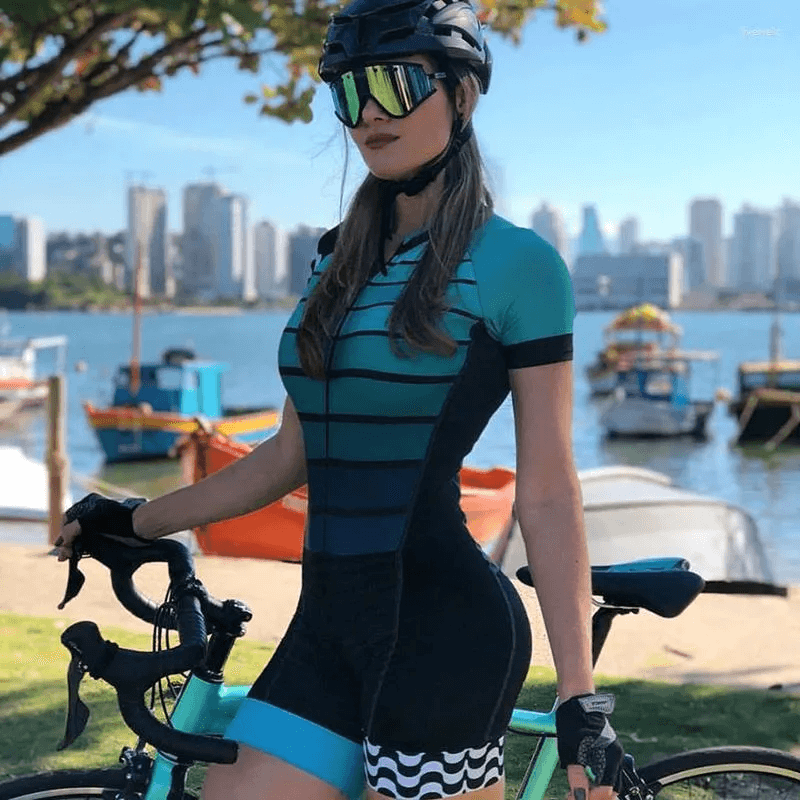It is essential to choose the appropriate size when purchasing short-sleeve cycling apparel in order to achieve the highest possible level of comfort, performance, and overall riding experience. YSTAR Wear providing a detailed advice on how to select the appropriate size for short-sleeve cycling jerseys and shirts. This study will investigate a wide range of dimensions and views pertaining to sizing, taking into consideration a variety of aspects including body measurements, preferences about fit, cycling disciplines, and variances connected to brands. In order for cyclists to make educated judgments on the selection of the proper size for their short-sleeve cycling apparel, it is necessary for them to have a thorough awareness of the major issues and to adhere to the guidelines that are recommended.

Given the Importance of Accurate Sizing
1.1 Comfort: Cycling apparel with short sleeves that is the appropriate size, when worn during rides, provides increased comfort. This allows for flexibility of movement, reduces the likelihood of chafing, and guarantees that proper ventilation and moisture management are performed.
1.2 Performance: Cycling jerseys and shirts that fit properly maximize aerodynamics and reduce wind resistance, which in turn improves performance and efficiency while riding a bicycle.
1.3 Regulation of Body Temperature: The appropriate size allows for effective heat dissipation and perspiration evaporation, which contributes to the maintenance of a consistent body temperature during riding.
1.4 Injury Prevention: Cycling clothing that does not fit properly can cause discomfort, movement restriction, and the possibility of injuries owing to excessive friction or pressure points.
Comparing and analyzing size charts
2.1 Measurements of the Body It is vital to take precise measurements of the body in order to determine the appropriate size. Measurements should be taken of the chest, waist, and hips by cyclists, and they should consult size tables that are specific to the brand for advice.
2.2 Preferences Regarding the Fit Take into consideration your own preferences regarding a relaxed, regular, or race-oriented fit. It is important to keep in mind that brand interpretations of fit categories can vary from one brand to another.
2.3 Size Consistency Although size charts offer a general guideline, it is essential to keep in mind that sizes might differ not just between brands but also between individual product lines within a brand. Consult the size chart that corresponds to each individual clothing at all times.
Take into account the following
3.1 Chest and Waist: The cycling gear with short sleeves should have a snug fit across the chest and waist, but it should not feel overly constricting or tight.
3.2 Sleeve Length: The sleeves should be long enough to cover the upper arm effectively, but they should not be extremely loose or flapping in the wind.
3.3 Collar and Neckline: The collar and neckline should be designed in such a way that they allow for easy mobility and ventilation while also maintaining a snug fit that minimizes unnecessary pain or chafing.
3.4 Hemline and Back Length: The hemline should be long enough to give enough covering, and the back length should be ideal for the cycling position. This will ensure that the jersey does not move around while you are riding.
Modifications to the fit and try-ons
4.1 Specific Recommendations for the Brand Some companies may offer specific recommendations for the fit of their products or indicate that the size be increased or decreased based on the measurements of the body. When determining the suitable size, it is important to take these recommendations into consideration.
Before making a purchase, it is recommended that you try on short-sleeve cycling apparel whenever it is possible to do so. This gives bikers the opportunity to evaluate the fit, comfort, and range of motion of the bike. Consider putting on the outfit in a cycling position so that you can experience the conditions of riding a bike.
In the event that the size that you have chosen does not live up to your expectations, it is important that you become familiar with the return and exchange policies of the merchant or brand.

Certain Considerations That Are Discipline-Matter
5.1 Road cycling jerseys often feature a slimmer, more aerodynamic fit than other types of cycling jerseys. If a more race-oriented fit is needed, you might want to consider scaling down; however, you should make sure that this does not compromise comfort or impede breathing.
5.2 Mountain Biking: Mountain bike jerseys may have a more relaxed fit, which allows for greater range of movement. Nevertheless, make sure that the sizing still has the ability to give adequate coverage and prevent excessive flapping.
5.3 Cycling for Leisure or Commuting: Cyclists may go toward a more relaxed fit for their leisure or commuting rides since it offers greater comfort and mobility. Nevertheless, make sure that the garment still allows for effective temperature control and that it prevents excessive fabric bunching throughout the garment.
5.4 input and Reviews: Take into consideration the possibility of reading product reviews and soliciting input from other cyclists who have purchased short-sleeve cycling apparel that is comparable to the one you are seeking. Their experiences can provide vital information about how well something fits, how accurately it is sized, and how satisfied they are overall.
Reassessment on a frequent Basis
Because one’s body form and preferences may shift over time, it is essential to reevaluate one’s size on a frequent basis when purchasing new short-sleeve cycling apparel. Consult the most recent size charts and take into account any modifications to the brand’s suggestions for the appropriate fit.
If you want to maximize your comfort, performance, and general enjoyment of riding, it is crucial to select the appropriate size when purchasing short-sleeve cycling apparel. riding enthusiasts are able to make educated selections regarding the selection of the proper size by taking into consideration a variety of aspects, including body dimensions, preferences regarding fit, riding disciplines, and variations in brand. When it comes to ensuring ideal comfort, flexibility of movement, and temperature regulation, accurate size is essential. On the other hand, clothes that do not fit properly can result in discomfort, decreased performance, and even serious injuries. Cycling enthusiasts may confidently select the appropriate size for their short-sleeve cycling jerseys and shirts by adhering to the rules that are recommended and taking into consideration their own personal preferences. This will result in an overall improvement in the quality of their cycling experience.



